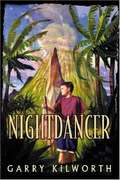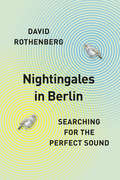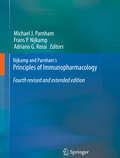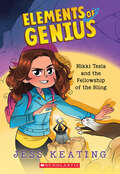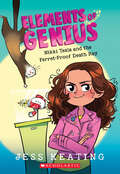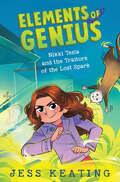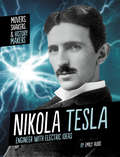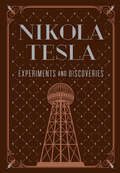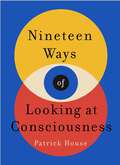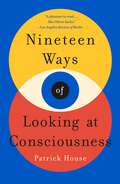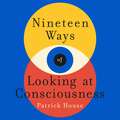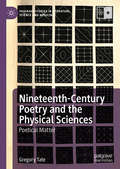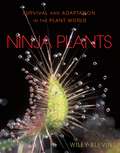- Table View
- List View
Night Walks: A Bedside Companion
by Joyce Carol OatesDozens of short stories selected by Oates for those people suffering from insomnia.
Night in the Middle Ages
by Jean Verdon George HolochNight for Medieval Europe was experienced Night is lit brightly for us moderns. It is experienced differently today than it was during medieval times. The author explores these differences. Also explored are similarities such as beds and how people react to fear and temptation.
Nightdancers
by Garry KilworthWhen a young boy finds an ancient Maori artifact on the Polynesian island where his parents are in the middle of an archaeological dig he little suspects what he is about to release from the past and from his own dreams. The myths of the island hold a dreadful warning for the present day.
Nightingales in Berlin: Searching for the Perfect Sound
by David RothenbergA celebrated figure in myth, song, and story, the nightingale has captivated the imagination for millennia, its complex song evoking a prism of human emotions,—from melancholy to joy, from the fear of death to the immortality of art. But have you ever listened closely to a nightingale’s song? It’s a strange and unsettling sort of composition—an eclectic assortment of chirps, whirs, trills, clicks, whistles, twitters, and gurgles. At times it is mellifluous, at others downright guttural. It is a rhythmic assault, always eluding capture. What happens if you decide to join in? As philosopher and musician David Rothenberg shows in this searching and personal new book, the nightingale’s song is so peculiar in part because it reflects our own cacophony back at us. As vocal learners, nightingales acquire their music through the world around them, singing amidst the sounds of humanity in all its contradictions of noise and beauty, hard machinery and soft melody. Rather than try to capture a sound not made for us to understand, Rothenberg seeks these musical creatures out, clarinet in tow, and makes a new sound with them. He takes us to the urban landscape of Berlin—longtime home to nightingale colonies where the birds sing ever louder in order to be heard—and invites us to listen in on their remarkable collaboration as birds and instruments riff off of each other’s sounds. Through dialogue, travel records, sonograms, tours of Berlin’s city parks, and musings on the place animal music occupies in our collective imagination, Rothenberg takes us on a quest for a new sonic alchemy, a music impossible for any one species to make alone. In the tradition of The Hidden Life of Trees and The Invention of Nature, Rothenberg has written a provocative and accessible book to attune us ever closer to the natural environment around us.
Nijkamp and Parnham's Principles of Immunopharmacology
by Michael J. Parnham Frans P. Nijkamp Adriano G. RossiPrinciples of Immunopharmacology provides a unique source of essential knowledge on the immune response, its diagnosis and its modification by drugs and chemicals. The 4th edition of this internationally recognized textbook has been revised to include recent developments, but continues the established format, dealing with four related fields in a single volume, thus obviating the need to refer to several different textbooks. The first section of the book, providing a basic introduction to immunology and its relevance for human disease, has been updated to accommodate new immunological concepts, particularly the role of epigenetics and the latest understanding of cancer immunology. The second section on immunodiagnostics offers a topical description of widely used molecular techniques and a new chapter on imaging techniques. This is followed by a systematic coverage of drugs affecting the immune system, including natural products. This third section contains 15 updated chapters, covering classical immunopharmacological topics such as anti-asthmatic, anti-rheumatic and immunosuppressive drugs, but also deals with antibiotics, plant-derived and dietary agents, with new chapters on monoclonal antibodies, immunotherapy in sepsis and infection, drugs for soft-tissue autoimmunity and cell therapy. The book concludes with a chapter on immunotoxicology and drug safety tests.Aids to the reader include a two-column format, glossaries of technical terms and appendix reference tables. The emphasis on illustrations is maintained from the first three editions. The book is a valuable single reference for undergraduate and graduate medical and biomedical students, postgraduate chemistry and pharmacy students, researchers in chemistry, biochemistry and the pharmaceutical industry and researchers lacking basic immunological knowledge, who want to understand the actions of drugs on the immune system.
Nikki Tesla and the Fellowship of the Bling (Elements of Genius #2)
by Jess KeatingOcean's 11 meets Spy School in this hilarious illustrated middle-grade adventure series featuring the world's greatest tween geniuses."For a group of geniuses who are supposed to help people, we do an awful lot of stealing."Nikki Tesla and the rest of the Genius Academy team have agreed to pilfer a completely priceless, totally lethal high-tech ring. Why? Because a mad scientist on a power trip plans to use it to do some serious damage. And because the very same mad scientist has kidnapped Mary Shelley. Mess with one genius, and you mess with them all.But mostly they're planning the heist of the century so Nikki can get to know her long-lost father who claims he isn't the criminal mastermind she believes him to be. After all, if a little international thievery can protect the world from evil, it just might save Nikki's family.
Nikki Tesla and the Ferret-Proof Death Ray (Elements of Genius #1)
by Jess KeatingOcean's 11 meets Spy School in this hilarious illustrated middle-grade series featuring the world's greatest minds."Let the official record show that, I, Nikki Tesla, did not intend to destroy the world."There are only so many times a kid can invent an instrument of global destruction without getting grounded. So when Nikki's death ray accidentally blows up her bedroom (if you can call a pet ferret with an itchy trigger finger an accident), she's sent to the only place that can handle her. Genius Academy is a school for history's greatest brains. Leo da Vinci? Charlotte Darwin? Bert Einstein? All extraordinary. Yet even among her fellow prodigies, Nikki feels like an outsider thanks to a terrible secret she can't let anyone discover. Ever. But when her death ray is stolen, Nikki must stop worrying about fitting in and learn to play nice with her new classmates. Because it doesn't take a genius to track a thief around the world, outwit the authorities, and keep a French fry-fanatic ferret happy. It takes all of them.
Nikki Tesla and the Traitors of the Lost Spark (Elements of Genius #3)
by Jess KeatingOcean's 11 meets Spy School in this hilarious illustrated middle-grade adventure series featuring the world's greatest tween geniuses.Genius Academy is under attack! When a routine operation goes horribly wrong, Nikki Tesla and the team take the blame for an international incident of epic proportions, and the school is shut down indefinitely. A little creative "research" tells them someone is planning biological warfare on a grand scale. But to get to the truth and clear their name, Nikki will have to find a miraculous antidote that can stop a criminal mastermind from blowing up the whole world.
Nikola Tesla for Kids: His Life, Ideas, and Inventions, with 21 Activities (For Kids series)
by Amy M. O'QuinnNikola Tesla was a physicist, scientist, electrical engineer, and world-renowned inventor whose accomplishments faded into oblivion after his death in 1943. Tesla was undeniably eccentric and compulsive; some considered him to be somewhat of a "mad" scientist. But in reality, he was a visionary. Many of his ideas and inventions that were deemed impossible during his lifetime have since become reality. He was the first to successfully use rotating magnetic fields to create an AC (alternating current) electrical power supply system and induction motor. He is now acknowledged to have invented the radio ahead of Marconi. Among other things, he developed the Tesla coil, an oscillator, generators, fluorescent tubes, neon lights, and a small remote-controlled boat. He helped design the world's first hydroelectric plant at Niagara Falls. Nikola Tesla for Kids is the story of Nikola Tesla's life and ideas, complete with a time line, 21 hands-on activities, and additional resources to better understand his many accomplishments.
Nikola Tesla: Engineer with Electric Ideas (Movers, Shakers, and History Makers)
by Emily HuddNikola Tesla was a scientist and inventor in the late 1800s and early 1900s. Among his many inventions and experiments, he helped create the modern electricity system. Learn more about Tesla's life as a famous inventor!
Nikola Tesla: Experiments and Discoveries
by Nikola TeslaTesla’s groundbreaking 1892 London lecture and his visionary paper on wireless technology, with an introduction by biographer W. Bernard Carlson.“All these observations fascinate us, and fill us with an intense desire to know more about the nature of these phenomena . . .” —Nikola TeslaIn February 1892, maverick inventor Nikola Tesla strode onto a stage at the Royal Institution of Electrical Engineers in London. The two-hour lecture he delivered mixed groundbreaking scientific theories about electricity, motors, and electromagnetism with dazzling showmanship. It was this combination of drama and intellect that turned Tesla into the cult figure that he remains today.Nikola Tesla: Experiments and Discoveries contains the complete published text of this lecture, originally titled “Experiments with Alternate Currents of High Potential and Low Frequency,” along with numerous illustrations of Tesla's experiments, as well as a biographical sketch of Tesla and his forward-thinking paper on wireless technology: “The Transmission of Electric Energy Without Wires.” This edition also features an introduction by W. Bernard Carlson, author of Tesla: Inventor of the Electrical Age.
Nile River Basin
by Assefa M. MelesseThis book presents results of scientific studies ranging from hydrological modelling to water management and policy issues in the Nile River basin. It examines the physical, hydrometeorological and hydrogeological description of the basin along with analysis in understanding the hydrological processes of the basin under the changing land-use stemming from population pressure and increased natural resources tapping. The book discusses the increased impact of climate change on the river flows, and such issues as water availability and demand, management and policy to offset the imbalance between demand and available resources. This book will be of interest to researchers, practitioners, water resources mangers, policy makers as well as graduate and undergraduate students. It is a useful reference text for ecohydrology, arid zone hydrology, hydrology of transboundary rivers and similar courses.
Nile Water Rights: An International Law Perspective
by Philine WehlingThe book provides a comprehensive assessment of the law governing the use and management of the Nile and considers, more broadly, how international water law can guide the development of a legal and institutional framework for cooperation over shared freshwater resources. It defines the current state of international water law and discusses the content of the United Nations Convention on the Law of the Non-Navigational Uses of International Watercourses. On this basis, it assesses the Nile water treaties and the 2010 Cooperative Framework Agreement for the Nile, and examines their compliance with international law, with a specific focus on the legal consequences of South Sudan's secession from Sudan. Moreover, the book recommends important amendments to the 2010 Agreement. Building on these recommendations, it addresses the implementation of the principle of equitable and reasonable use regarding the Nile, illustrating the extent to which the principle can provide a conceptual framework for regulating water use. The book is a valuable resource for academics and practitioners alike as it combines legal assessment with a discussion of how international water law principles can be implemented in practice.“Essential reading for anyone interested in understanding international law related to the Nile River basin, including its evolution, current challenges and future prospects.” - Professor Alistair Rieu-Clarke, Chair in Law, Law School, Northumbria University, Newcastle “A true must-read for anyone interested in the developing Nile River legal and institutional regime and in how to implement international water law principles and guidance at the transboundary river basin level. Most notably, the book operationalizes the principle of equitable use and applies it to the Nile, pointing the way forward for the cooperative management of the river’s resources.” - Stefano Burchi, Chairman of the Executive Council, International Association for Water Law (AIDA)
Nile and Grand Ethiopian Renaissance Dam: Past, Present and Future (Springer Geography)
by Wossenu Abtew Assefa M. Melesse Semu A. MogesThis book is a contribution by the presenters of the 2020 International Conference on the Nile and Grand Ethiopian Renaissance Dam (GERD). The Nile basin is facing unprecedented level of water right challenges after the construction of GERD has begun. Ethiopia, Egypt and Sudan have struggled to narrow their differences on filling and operation of the GERD. The need for science and data-based discussion for a lasting solution is crucial. Historical perspectives, water rights, agreements, failed negotiations, and other topics related to the Nile is covered in this book. The book covers Nile water claims past and present, international transboundary basin cooperation and water sharing, Nile water supply and demand management, Blue Nile/Abbay and Grand Ethiopian Renaissance Dam, land and water degradation and watershed management, emerging threats of the Lakes Region in the Nile Basin, and hydrologic variation and monitoring. This book is beneficial for students, researchers, sociologists, engineers, policy makers, lawyers, water resources and environmental managers and for the people and governments of the Nile Basin.
Nine Chapters on Mathematical Modernity: Essays on the Global Historical Entanglements of the Science of Numbers in China (Transcultural Research – Heidelberg Studies on Asia and Europe in a Global Context)
by Andrea BréardThe book addresses for the first time the dynamics associated with the modernization of mathematics in China from the nineteenth to the mid-twentieth century from a transcultural global historical perspective. Rather than depict the transformations of mathematical knowledge in terms of a process of westernization, the book analyzes the complex interactions between different scientific communities and the ways in which the past, modernity, language, and mathematics were negotiated in a global context. In each chapter, Andrea Bréard provides vivid portraits of a series of go-betweens (such as translators, educators, or state statisticians) based on a vast array of translated primary sources hitherto unavailable to a non-Chinese readership. They not only illustrate how Chinese scholars mediated between new mathematical objects and discursive modes, but also how they instrumentalized their autochthonous scientific roots in specific political and intellectual contexts. While sometimes technical in style, the book addresses all readers who are interested in the global and cultural history of science and the complexities involved in the making of universal mathematics. “While the pursuit of modernity is in the title, entanglement is of as much interest. Using the famous ‘Nine Chapters’ as a framework, Bréard considers a wide range of that entanglement from divination to data management. Bréard’s analysis and thought-provoking insights show once again how much we can learn when two cultures intersect. A fascinating read!” (John Day, Boston University).
Nine Minds: Inner Lives on the Spectrum
by Daniel TammetFrom the New York Times–bestselling author of Born on a Blue Day and Thinking in Numbers, this poignant, perspective-altering book celebrates the power and beauty of the neurodivergent mind, as told through the true stories of nine contemporary men and women on the autism spectrum. “Tammet’s exquisite portraits remind us that the variety of brains is every bit as essential as any other form of diversity.”—Andrew Solomon, author of Far from the Tree Exploding the tired stereotypes of autism, Daniel Tammet—acclaimed author and an autistic savant himself—draws out the inner worlds of nine extraordinary, neurodivergent lives from around the globe. A nonverbal man from Boston explores body language, gesture by eloquent gesture, in his mother’s yoga classes. A Japanese researcher in psychology sets out to measure loneliness while drawing on her own experience of autism. From a Fields Medal–winning mathematician to a murder detective, a pioneering surgeon to a bestselling novelist, each is remarkable in their field, and each is changing how the world sees those on the spectrum. Telling stories as richly diverse as the spectrum itself, this perspective-altering, life-affirming work of narrative nonfiction celebrates the power and beauty of the neurodivergent mind—and the daring freedom with which these individuals have built their lives.
Nine Months: Before a Baby Is Born
by Miranda PaulJoin a family of three who spend nine whole months waiting, from a frosty winter through a sun-dappled summer, until finally . . . a baby is here.A Boston Globe - Horn Book Honor RecipientAn NSTA Outstanding Science Trade Book for StudentsA Capitol Choices Noteworthy TitleA soon-to-be big sister and her parents prepare for the arrival of a new baby in the family. Alternating panels depict what the family is experiencing in tandem with how the baby is growing, spanning everything from receiving the news about the new baby to the excitement of its arrival. In this pregnancy book unlike any other one out there, watch what's actually happening through meticulously detailed, actual size illustrations, perfectly paired with a lyrical yet informative text, and culminating in a warm, joyful birth scene. Complete with backmatter that includes an elaboration on pregnancy, a list of amazing things babies can do before they're born, and more, Miranda Paul and Caldecott Medalist Jason Chin deliver another spectacular nonfiction picture book.A Kirkus Reviews Best Book of the YearA Horn Book Best Book of the YearA Bank Street Best Book of the Year - Outstanding Merit
Nine Pints: A Journey Through the Money, Medicine, and Mysteries of Blood
by Rose GeorgeLos Angeles Times Book Prize Finalist: A “compelling chronicle” of the science, politics, and business of blood (The Wall Street Journal).Blood carries life, yet the sight of it makes people faint. It is a waste product and a commodity pricier than oil. It can save lives and transmit deadly infections. Each one of us has roughly nine pints of it, yet many don’t even know their own blood type. And for all its ubiquitousness, the few tablespoons of blood discharged by 800 million women are still regarded as taboo: menstruation is perhaps the single most demonized biological event.Rose George, author of The Big Necessity, takes us from ancient practices of bloodletting to the breakthrough of the “liquid biopsy,” which promises to diagnose cancer and other diseases with a simple blood test. She introduces Janet Vaughan, who set up the world’s first system of mass blood donation during the Blitz, and Arunachalam Muruganantham, known as “Menstrual Man” for his work on sanitary pads for developing countries. She probes the lucrative business of plasma transfusions, in which the US is known as the “OPEC of plasma.” And she looks to the future, as researchers seek to bring synthetic blood to a hospital near you. Spanning science and politics, individual’s stories and global epidemics, Nine Pints reveals our life’s blood in an entirely new light.One of Bill Gates’ Recommended Summer Reading Titles“Stellar . . . An informative, elegant, and provocative exploration of the life-giving substance . . . A wondrously well-written work.” —Booklist (starred review)Both fascinating and informative . . . George packs her book with the kinds of provocative, witty, and rigorously reported facts and stories sure to make readers view the integral fluid coursing through our veins in a whole new way.” —Kirkus Reviews (starred review)“George charges down wholly unexpected avenues of medical history and global injustice, leaving the reader by turns giddy and appalled. And always, always in awe of the writing.” —Mary Roach, author of Grunt: The Curious Science of Humans at War“A very good book.” —The New York Times
Nineteen Ways of Looking at Consciousness
by Patrick HouseA concise, elegant, and thought-provoking exploration of the mystery of consciousness and the functioning of the brain.Despite decades of research, remarkable imagery, and insights from a range of scientific and medical disciplines, the human brain remains largely unexplored. Consciousness has eluded explanation.Nineteen Ways of Looking at Consciousness offers a brilliant overview of the state of modern consciousness research in twenty brief, revealing chapters. Neuroscientist and author Patrick House describes complex concepts in accessible terms, weaving brain science, technology, gaming, analogy, and philosophy into a tapestry that illuminates how the brain works and what enables consciousness. This remarkable book fosters a sense of mystery and wonder about the strangeness of the relationship between our inner selves and our environment.
Nineteen Ways of Looking at Consciousness
by Patrick HouseA concise, elegant, and thought-provoking exploration of the mystery of consciousness and the functioning of the brain.Despite decades of research, remarkable imagery, and insights from a range of scientific and medical disciplines, the human brain remains largely unexplored. Consciousness has eluded explanation.Nineteen Ways of Looking at Consciousness offers a brilliant overview of the state of modern consciousness research in twenty brief, revealing chapters. Neuroscientist and author Patrick House describes complex concepts in accessible terms, weaving brain science, technology, gaming, analogy, and philosophy into a tapestry that illuminates how the brain works and what enables consciousness. This remarkable book fosters a sense of mystery and wonder about the strangeness of the relationship between our inner selves and our environment.
Nineteen Ways of Looking at Consciousness: Our leading theories of how your brain really works
by Patrick HouseAn overview of modern consciousness research and how our brain works.A concise, elegant, and thought-provoking exploration of the mystery of consciousness and the functioning of the brain.Despite decades of research, remarkable imagery, and insights from a range of scientific and medical disciplines, the human brain remains largely unexplored. Consciousness has eluded explanation.Nineteen Ways of Looking at Consciousness offers a brilliant overview of the state of modern consciousness research in twenty brief, revealing chapters. Neuroscientist and author Patrick House describes complex concepts in accessible terms, weaving brain science, technology, gaming, analogy, and philosophy into a tapestry that illuminates how the brain works and what enables consciousness. This remarkable book fosters a sense of mystery and wonder about the strangeness of the relationship between our inner selves and our environment.(P)2020 Macmillan Audio
Nineteenth-Century British Secularism: Science, Religion and Literature (Histories of the Sacred and Secular, 1700-2000)
by Michael RectenwaldNineteenth-Century British Secularism offers a new paradigm for understanding secularization in the nineteenth century. It addresses the crisis in the secularization thesis by foregrounding a nineteenth-century development called 'Secularism' – the particular movement and creed founded by George Jacob Holyoake from 1851 to 1852. Nineteenth-Century British Secularism rethinks and reevaluates the significance of Holyoake's Secularism, regarding it as a historic moment of modernity and granting it centrality as both a herald and exemplar for a new understanding of modern secularity. In addition to Secularism proper, the book treats several other moments of secular emergence in the nineteenth century, including Thomas Carlyle's 'natural supernaturalism', Richard Carlile's anti-theist science advocacy, Charles Lyell's uniformity principle in geology, Francis Newman's naturalized religion or 'primitive Christianity', and George Eliot's secularism and post-secularism.
Nineteenth-Century Poetry and the Physical Sciences: Poetical Matter (Palgrave Studies in Literature, Science and Medicine)
by Gregory TatePoetical Matter examines the two-way exchange of language and methods between nineteenth-century poetry and the physical sciences. The book argues that poets such as William Wordsworth, Mathilde Blind, and Thomas Hardy identified poetry as an experimental investigation of nature’s materiality. It also explores how science writers such as Humphry Davy, Mary Somerville, and John Tyndall used poetry to formulate their theories, to bestow cultural legitimacy on the emerging disciplines of chemistry and physics, and to communicate technical knowledge to non-specialist audiences. The book’s chapters show how poets and science writers relied on a set of shared terms (“form,” “experiment,” “rhythm,” “sound,” “measure”) and how the meaning of those terms was debated and reimagined in a range of different texts.“A stimulating analysis of nineteenth-century poetry and physics. In this groundbreakingstudy, Tate turns to sound to tease out fascinating continuities acrossscientific inquiry and verse. Reflecting that ‘the processes of the universe’ werethemselves ‘rhythmic,’ he shows that a wide range of poets and scientists werethinking through undulatory motion as a space where the material and the immaterialmet. ‘The motion of waves,’ Tate demonstrates, was ‘the exemplary form inthe physical sciences.’ Sound waves, light, energy, and poetic meter were eachcharacterized by a ‘process of undulation,’ that could be understood as both aphysical and a formal property. Drawing on work in new materialism and newformalism, Tate illuminates a nineteenth-century preoccupation with dynamic patterningthat characterizes the undulatory as (in John Herschel’s words) not ‘things,but forms.’”—Anna Henchman, Associate Professor of English at Boston University, USA“This impressive study consolidates and considerably advances the field of physicsand poetry studies. Moving easily and authoritatively between canonical and scientistpoets, Nineteenth-Century Poetry and the Physical Sciences draws scientificthought and poetic form into telling relation, disclosing how they were understoodvariously across the nineteenth century as both comparable and competingways of knowing the physical world. Clearly written and beautifully structured,Nineteenth-Century Poetry and the Physical Sciences is both scholarly and accessible,a fascinating and indispensable contribution to its field.”—Daniel Brown, Professor of English at the University of Southampton, UK“Essential reading for Victorianists. Tate’s study of nineteenth-century poetry andscience reconfi gures debate by insisting on the equivalence of accounts ofempirical fact and speculative theory rather than their antagonism. Theundulatory rhythms of the universe and of poetry, the language of science and ofverse, come into new relations. Tate brilliantly re-reads Coleridge, Tennyson,Mathilde Blind and Hardy through their explorations of matter and ontologicalreality. He also addresses contemporary theory from Latour to Jane Bennett.” — Isobel Armstrong, Emeritus Professor of English at Birkbeck, University of London, UK
Ninita's Big World: The True Story of a Deaf Pygmy Marmoset
by Sarah Glenn MarshThe heart-tugging true story of how YouTube star Ninita—a deaf, orphaned pygmy marmoset (the smallest type of monkey)—found family, friendship, and a forever home! Illustrated in full color. Ninita is the only known deaf pygmy marmoset in the world, but that doesn't stop her from making friends and chasing her next adventure! Abandoned by her parents and rescued by the RSCF, this tiny, curious monkey loves exploring her habitat. And when she meets Mr. Big—another pygmy marmoset—she has finally found a friend who likes to eat, climb, and play as much as she does. A YouTube celebrity, Ninita's videos have been viewed nearly 2 million times! Published in partnership with the RSCF, this charming true story of how one little orphaned monkey got a second chance to have a family gently introduces kids to disability, biodiversity, and wildlife conservation.
Ninja Plants: Survival and Adaptation in the Plant World
by Wiley BlevinsWhat can communicate but has no mouth, and can attack but has no hands? A plant! You might love the beauty and fragrance of flowers, but plants are far more complex than meets the eye. Some plants have ways of luring insects for pollination. Others mimic the look of the female insects whose male counterparts they want to attract. The Venus flytrap eats insects and other small animals for extra nourishment. You might see some of these ninja plants—with their sneaky and deceitful ways—in your own backyard. These plants might even be sitting on a windowsill in your home. This fascinating world of ninja plants is waiting to be discovered.

